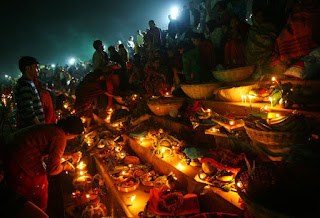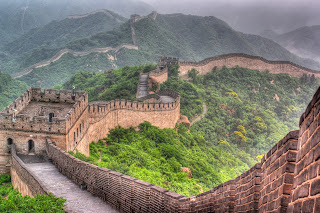Chhath Puja
Official name :- Chhath Puja
Also called :- Chhathi
Chhath Parv
Chhath Puja
Dala Chhath
Dala Puja
Surya Shashthi
Observed by:- Hindus
Liturgical Color:-Colors related to Hinduism Saffron (or Bhagwa) Type Cultural, Historical, Religious.
Significance:- To thank Surya (Sun) for bestowing the bounties of life on earth and fulfilling particular wishes
Chhath is an ancient Hindu Vedic festival dedicated to the Hindu Sun God, Surya and Chhathi Maiya (ancient Vedic Goddess ; Usha - wife of Sun God ).
The Chhath Puja is performed in order to thank Surya for sustaining life on earth and to request the granting of certain wishes.
This festival is observed by Nepalese people and Indian people along with their diaspora.
The Sun, considered as the god of energy and of the life-force, is worshiped during the Chhath festival to promote well-being, prosperity and progress. In Hinduism, Sun worship is believed to help cure a variety of diseases, including leprosy, and helps ensure the longevity and prosperity of family members, friends, and elders.
The rituals of the festival are rigorous and are observed over a period of four days. They include holy bathing, fasting and abstaining from drinking water (Vratta), standing in water for long periods of time, and offering prashad (prayer offerings) and arghya to the setting and rising sun.
Although the festival is observed most elaborately in Mithila Region of Nepal, Terai-Madhesh of Nepal, Indian states of Bihar, Jharkhand and eastern UP, it is also more prevalent in areas where migrants from those areas have a presence. It is celebrated in all Northern regions and major Northern urban centers in India bordering Nepal. The festival is celebrated in the regions including but not exclusive to the northeast region of India, Madhya Pradesh, Uttar Pradesh, Chhattisgarh, Chandigarh, Gujarat,Bangalore,Mauritius, Fiji, South Africa, Trinidad and Tobago, Guyana, Suriname, Jamaica, other parts of the Caribbean, United States, United Kingdom, Republic of Ireland, Australia, New Zealand, Malaysia, Macau, Japan, and Indonesia.
History of Chhath
It is believed that the ritual of Chhath puja may even predate the ancient Vedas texts, as the Rigveda contains hymns worshiping the Sun god and describes similar rituals. The rituals also find reference in the Sanskrit epic poem Mahābhārata in which Draupadi is depicted as observing similar rites.
In the poem, Draupadi and the Pandavas, rulers of Indraprastha (modern Delhi), performed the Chhath ritual on the advice of noble sage Dhaumya. Through her worship of the Sun God, Draupadi was not only able to solve her immediate problems, but also helped the Pandavas later regain their lost kingdom.
Its yogic/scientific history dates back to the Vedic times. The rishis of yore used this method to remain without any external intake of food as they were able to obtain energy directly from the sun's rays. This was done through the Chhath method.
Another history behind celebrating the Chhath puja is the story of Lord Rama. It is considered that Lord Rama of India and Sita of Nepal had kept fast and offer puja to the Lord Sun in the month of Kartika in Shukla Paksh during their coronation after returning to the Ayodhya after 14 years of exile. From that time, chhath puja became the significant and traditional festival in the Hindu religion and started celebrating every year at the same date in Sita's homeland Janakpur and adjoining Indian states of Bihar but has not been popular in Rama's kingdom of Ayodhya.
Also called :- Chhathi
Chhath Parv
Chhath Puja
Dala Chhath
Dala Puja
Surya Shashthi
Observed by:- Hindus
Liturgical Color:-Colors related to Hinduism Saffron (or Bhagwa) Type Cultural, Historical, Religious.
Significance:- To thank Surya (Sun) for bestowing the bounties of life on earth and fulfilling particular wishes
Chhath is an ancient Hindu Vedic festival dedicated to the Hindu Sun God, Surya and Chhathi Maiya (ancient Vedic Goddess ; Usha - wife of Sun God ).
The Chhath Puja is performed in order to thank Surya for sustaining life on earth and to request the granting of certain wishes.
This festival is observed by Nepalese people and Indian people along with their diaspora.
The Sun, considered as the god of energy and of the life-force, is worshiped during the Chhath festival to promote well-being, prosperity and progress. In Hinduism, Sun worship is believed to help cure a variety of diseases, including leprosy, and helps ensure the longevity and prosperity of family members, friends, and elders.
The rituals of the festival are rigorous and are observed over a period of four days. They include holy bathing, fasting and abstaining from drinking water (Vratta), standing in water for long periods of time, and offering prashad (prayer offerings) and arghya to the setting and rising sun.
Although the festival is observed most elaborately in Mithila Region of Nepal, Terai-Madhesh of Nepal, Indian states of Bihar, Jharkhand and eastern UP, it is also more prevalent in areas where migrants from those areas have a presence. It is celebrated in all Northern regions and major Northern urban centers in India bordering Nepal. The festival is celebrated in the regions including but not exclusive to the northeast region of India, Madhya Pradesh, Uttar Pradesh, Chhattisgarh, Chandigarh, Gujarat,Bangalore,Mauritius, Fiji, South Africa, Trinidad and Tobago, Guyana, Suriname, Jamaica, other parts of the Caribbean, United States, United Kingdom, Republic of Ireland, Australia, New Zealand, Malaysia, Macau, Japan, and Indonesia.
History of Chhath
It is believed that the ritual of Chhath puja may even predate the ancient Vedas texts, as the Rigveda contains hymns worshiping the Sun god and describes similar rituals. The rituals also find reference in the Sanskrit epic poem Mahābhārata in which Draupadi is depicted as observing similar rites.
In the poem, Draupadi and the Pandavas, rulers of Indraprastha (modern Delhi), performed the Chhath ritual on the advice of noble sage Dhaumya. Through her worship of the Sun God, Draupadi was not only able to solve her immediate problems, but also helped the Pandavas later regain their lost kingdom.
Its yogic/scientific history dates back to the Vedic times. The rishis of yore used this method to remain without any external intake of food as they were able to obtain energy directly from the sun's rays. This was done through the Chhath method.
Another history behind celebrating the Chhath puja is the story of Lord Rama. It is considered that Lord Rama of India and Sita of Nepal had kept fast and offer puja to the Lord Sun in the month of Kartika in Shukla Paksh during their coronation after returning to the Ayodhya after 14 years of exile. From that time, chhath puja became the significant and traditional festival in the Hindu religion and started celebrating every year at the same date in Sita's homeland Janakpur and adjoining Indian states of Bihar but has not been popular in Rama's kingdom of Ayodhya.







Comments
Post a Comment